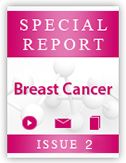Study Links pCR Post-Neoadjuvant Therapy to Increased Survival Rates in TNBC
Treatment with standard neoadjuvant chemotherapy plus carboplatin and/or bevacizumab resulting in a pathologic complete response has been associated with improvement in event-free and overall survival in patients with triple-negative breast cancer.
Increased Survival Rates in TNBC

William Sikov, MD
Treatment with standard neoadjuvant chemotherapy plus carboplatin and/or bevacizumab resulting in a pathologic complete response (pCR) has been associated with improvement in event-free (EFS) and overall survival (OS) in patients with triple-negative breast cancer (TNBC). However, it was unclear whether either were independently associated with EFS or OS benefit, according to long-term data from the phase II CALGB 40603 trial presented at the 2015 San Antonio Breast Cancer Symposium.
"Our new data show that patients on any arm of this study who had a pCR had far superior outcomes compared with those who did not have a pCR,” lead study author William Sikov, MD, associate director of Clinical Research, Program in Women’s Oncology, Women and Infants Hospital of Rhode Island, said in a statement.
The CALGB 40603 open-label phase II trial included 443 patients with stage II/III triple-negative breast cancer. All patients received 80 mg/m2 of paclitaxel weekly for 12 weeks, followed by doxorubicin plus cyclophosphamide every 2 weeks for 4 cycles. In a 2 x 2 schema, patients were randomized to the chemotherapy backbone alone or to 4 cycles of concurrent carboplatin (area under curve = 6) every 3 weeks and/or 10 mg/kg of bevacizumab every 2 weeks for 9 cycles.
“The study met its primary endpointthat is, the addition of carboplatin increased pCR rates in both the breast and the breast/axilla in a significant fashion. The addition of bevacizumab increased pCR rates in the breast, and had a borderline increase in the pCR rate in the breast/axilla,” Sikov said in a press briefing at SABCS, where he presented the data.
Adding carboplatin increased pCR in the breast from 46% to 60% (P = .0018), while adding bevacizumab increased pCR from 48% to 59% (P = .0089). In the breast/axilla, carboplatin significantly increased the pCR rate from 41% to 54% (P = .0029); however, the increase in pCR rate with bevacizumab of 44% to 52% was nonsignificant (P = .0570).
The median follow-up was 39 months (maximum, 66 months) for the long-term data presented at SABCS. At the time of the data analysis, there had been 110 EFS events and 77 OS events.
For the overall study, the 3-year EFS and OS rates were 74% and 83%, respectively. “Given the aggressive biology of triple-negative breast cancer, we suspect that these [EFS and OS] curves are reaching their plates in the near future,” said Sikov.
Among patients with a pCR in the breast (n = 231), 3-year EFS was 84.8% compared with 61.8% for patients without a pCR (n = 212; HR, 0.33; 95% CI, 0.22-0.50; P <.0001). The risk of death was reduced by 72% among patients with a pCR in the breast (HR, 0.28; 95% CI, 0.17-0.46).
Patients with a pCR in the breast and axilla (n = 207), had a 3-year EFS of 86%, compared with 62% of patients without a pCR (HR, 0.30; 95% CI, 0.19-0.45; P <.0001). Overall survival among these patients was 93% versus 73%, respectively (HR, 0.20; 95% CI, 0.11-0.36; P <.0001).
Further, patients achieving a pCR in the breast and axilla had lower 3-year rates of ipsilateral breast recurrences (2.9% vs 13.3% for those without a pCR), other locoregional recurrences (1.5% vs 6.6%), distant recurrences (9.2% vs 26.5%), all deaths (6.8% vs 28.3%), and breast cancerattributed deaths (5.8% vs 25.2%).
The researchers also examined the impact of the amount of residual disease. Among the 60% of patients with either a pCR in the breast and axilla or minimal residual disease (n = 266) the HR for EFS was 0.29 and the HR for OS was 0.21. “The addition of [minimal residual disease] patients does not diminish the prognostic significance associated with pCR in the breast/axilla,” said Sikov.
The 3-year EFS rate was 76% with carboplatin versus 71% without the drug (HR, 0.84; 95% CI (0.58-1.22). Three-year OS rates were 81% versus 85%, respectively (HR, 1.15; 95%, 0.74-1.79).
Among patients receiving bevacizumab, the 3-year EFS rate was 75% versus 72% in patients who did not receive the angiogenesis inhibitor (HR, 0.80; 0.55-1.17). Three-year OS rates were 85% versus 81%, respectively (HR, 0.76; 95% CI, 0.49-1.19).
“There were no statistically significant differences in event-free survival and overall survival with the addition of carboplatin or bevacizumab compared with patients who did not receive those agents,” Sikov said.
“On the basis of these results, at the present time, neither carboplatin nor bevacizumab should be considered part of the standard neoadjuvant chemotherapy regimen for stage II or III TNBC,” he added.
The study design offers one possible explanation for this lack of a demonstrated benefit. “Our study was underpowered to determine whether the increases in the pCR rates seen with the addition of carboplatin and bevacizumab improves EFS or OS,” said Sikov.
“Going forward, the question is whether we want to commit the additional patients and resources necessary to answer this question or instead focus our research efforts in TNBC on other opportunities to improve outcomes,” he concluded.
References
- Sikov WM, Berry DA, Perou CM, et al. Event-free and overall survival following neoadjuvant weekly paclitaxel and dose-dense AC +/- carboplatin and/or bevacizumab in triple-negative breast cancer: outcomes from CALGB 40603 (Alliance). Presented at: 2015 San Antonio Breast Cancer Symposium; San Antonio, TX; December 8-12, 2015. Abstract: S2-05.

Biomarker Testing Paves the Way for Better Targeted Therapies in NSCLC
April 16th 2024At a live virtual event, Edward S. Kim, MD, MBA, discussed the evolving landscape of biomarker testing before making treatment decisions for patients with early-stage non–small cell lung cancer (NSCLC).
Read More
Breast Cancer Leans into the Decade of Antibody-Drug Conjugates, Experts Discuss
September 25th 2020In season 1, episode 3 of Targeted Talks, the importance of precision medicine in breast cancer, and how that vitally differs in community oncology compared with academic settings, is the topic of discussion.
Listen
UGT1A1 Status Underutilized in Predicting Sacituzumab Toxicity in MBC
April 8th 2024During a Case-Based Roundtable® event, Mark Pegram, MD, discussed the value of testing for UGT1A1 status in patients receiving sacituzumab govitecan for hormone receptor–positive breast cancer in the second article of a 2-part series.
Read More